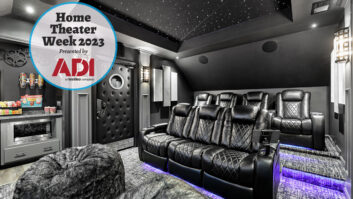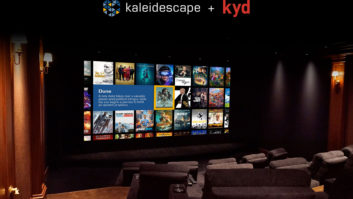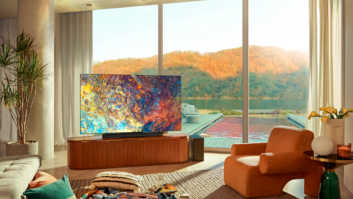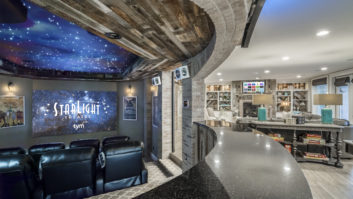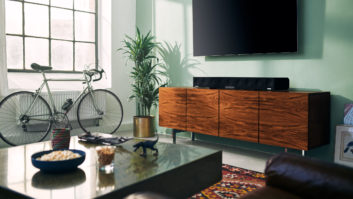Todays home theaters utilize widescreen 16:9 HD video displays in combination with 7.1 multichannel sound systems to deliver a truly immersive experience to the audience. But as every custom integrator knows, merely ordering an HD display and a surround-sound receiver or processor and speakers does not necessarily make for a compelling home theater. To achieve the proper experience, you must first qualify your customer, evaluate the specific demands of their project, and correctly assess your customers expectations.
At the outset, it is important to get a clear picture in your mind of what your goal is, advised John Dahl, senior fellow and director of education for THX Ltd. I recommend, as a goal, putting up an audio system that totally involves the listener in the entertainment experience, he said. To obtain that degree of listener/viewer involvement, Dahl recommends designing a room with seats that give you a good view of where the sound is coming from, and seats that are located in such a way that the room itself isnt going to screw things up.
Size Matters
The size of the room is among the first things that youll need to determine, both in linear dimensions and in terms of cubic feet or cubic meters. How many seats will it need to accommodate? Almost all of your planning will proceed from these established points.
With regard to speakers, Paul DiComo, VP of marketing for Definitive Technology said, Find out what degree of visibilityor invisibilityyour client is looking for. Taking the audiophile approach, DiComo favors freestanding speakers, if they dont conflict with the clients visual aesthetics. Youve got to understand the room, the cosmetics of the room, and how that will play out, before you can really make equipment choices, DiComo noted.
Optimal screen size is a function of viewing distancebut acoustical performance in the bass range is dramatically influenced by room modes (standing waves) and listening position. Therefore, your challenge will be to find a listening/viewing position that performs well not only visually, but audibly, too.
Dahl recommends as a first step in exploring potential seating locations that you initially find out which room locations offer reasonably smooth frequency response, particularly across the bass range. To further heighten the challenge, home theatersbecause theyre likely to be used for group entertainmentcall for good sound in all or most of the seats, rather than just one or two golden seats.
One of the most promising methods of obtaining more uniform bass response across a wider area is to use multiple subwoofers. According to an engineering paper published by Harman International researcher Todd Welti, two subwoofers, optimally placed, provide more uniform bass performance across a range of room locations than does a single suband four subs do significantly better than two.
Achieving Reference Sound Levels
Dahl pointed out that when movie soundtracks are mixed in the studio, the reference sound level is 85 dB SPL. This allows for instantaneous sonic peaks to be 20 dB higher, at 105 dB SPL (i.e., 20 dB of headroom). If the home theater is going to duplicate the commercial cinema experience, itll need to be capable of matching these sound levels. Therefore, it is up to the custom integrator to determine whether the sound system can indeed reach those peaks without creating distortion.
Dahl noted that loudspeaker data sheets typically give no indications of what maximum sound levels can be achieved, given a specific room volume and listening distance. If youre using THX-certified speaker systems, however, your chances of success may improve. Products bearing THX Select certification have been verified as capable of 105 dB maximum output in a 2,000 cubic foot room at a listening position nine feet from the front speakers. THX Ultra or Ultra2 speaker systems can achieve the same levels in a 3,000-cubic-foot room, at a 12-foot listening distance.
Theres no harm in using THX Ultra or Ultra2-certified products in a room less than 3,000-cubic-feet. Itll just play louder than you need, Dahl observed. THX-certified speakers could be used in a room larger than 2,000 cubic feet, but the trade-off is that you may not achieve 105-dB levels, which may be fine, Dahl said, because 105 dB is really loudstudio loud.
Just how much amplifier power is required to drive these systems to these levels? Its a complex answer, as it depends on speaker sensitivity and dispersion patterns, room volume, listening distance, and, to a lesser extent, on the rooms acoustical treatment. Here again, for THX-certified products, things are simplified because they have been tested to provide Select loudspeaker systems with sufficient amplifier power. Establishing that is part of the THX evaluation and certification process. (By the same token, matching THX Ultra or Ultra2 electronics with Ultra or Ultra2 speakers also ensures adequate amplifier power for the larger room volume on which this certification level is based.)
If youre not going with THX-certified products, itll be up to you to do much of the evaluation process yourself.
X.1 Sound
Most newer AV receivers and processors support seven channels of audio, plus the low-frequency effects (LFE) channel (7.1 surround sound), and both DiComo and Dahl agree that this is usually the best choice, unless the listening room is very small.
My personal feeling is that cramming seven speakers into a really small room is a dumb thing to do, DiComo said. Dahl also noted that in those situations where the listening position is right up against the back wall (among the worst possible listening positions, acoustically), youll be more or less compelled to use a 5.1 layout, with the two surround speakers on either side of the listening position and approximately two feet above listeners ear levels.
In more normal-sized rooms, and with adequate space behind the listening area, 7.1 multichannel layouts will be preferredparticularly for theaters where the listening area is several tiers deep. In these situations, having more channels makes it easier to obtain the desired ambiance effects, making it less obvious to listeners that sounds are emanating from discrete speaker locations.
Once you know the room dimensions, the number of seats, and where theyll be, taking into account the best seating locations from an acoustical standpoint, you can then determine the viewing distance (distance from screen to prime viewing seats). With that distance established, the next task is to determine the screen size.
The THX recommendation for 16:9 HDTVs is to have a 40-degree viewing angle for the prime viewing seats. The viewing distance multiplied by 0.73 will give you the needed screen width (the screen width that yields a 40-degree viewing angle). As an example, for a viewing distance of 12 feet (144 inches), multiplying 144 by 0.73 yields a screen width of just over 105 inches. (You can use inches, feet, or meters in the formula, as long as you use the same throughout.)
Many clients will want to start by first picking the screen size, but that amounts to putting the cart before the horse, because, if you fix the screen size, that also dictates the viewing distance (assuming you want to best utilize the available screen resolution). And fixing the viewing distance determines where the seats will be, which may or may not be in a good location, acoustically.
THX recommends a 45-degree included angle between the left and right front speakers (i.e., each speaker about 22.5 degrees off the centerline axis). This fits well with the 40-degree horizontal width of the video image. Dahl said that the left and right surround speakers should be in the range of 90 to 110 degrees off-axis, and about two feet above listeners ear level. For the rear surrounds of a 7.1 system, face the back wall, and place them so that theres a 60-degree spread between them. These should also be about two feet above listeners ear level. These placement recommendations agree fairly closely with those of Dolby Laboratories, which has its guidelines at www.dolby.com.
DiComo noted that one thing to avoid is putting the left and right front speakers in the corners. Even if youre using in-walls for the main speakers, hopefully the room width will be sufficient to allow you to keep the left and right speakers well away from the sidewalls, to minimize the deleterious effects of cancellations from sidewall reflections.
When considering the electronics (receivers or power amps) DiComo also recommends taking a close look at how amplifier power ratings are stated, as not all watts are necessarily alike. Youll want to know the RMS power ratingnot peak power, and youll want to be sure that it specifies what load impedance is being driven. Is the power output for each channel specified with all channels driven? If that isnt mentioned, then its likely that the specified output only applies when a single channel is driven; it can sag dramatically when all channels are driven.
Whats the impedance of the speakers you have in mind? If its 8 ohms, that should be fine, as most amplifiers have power output specified for 8-ohm loads. But if the speaker is 4 ohms, be sure to check the amplifiers power output rating for 4-ohm loads. If one isnt given, the amp may not be designed to drive such loads.
Ideally, youll want an amplifier that can deliver the required power across the frequency range (not just at, say, 1 kHz), into a load impedance that matches the speakers you have in mind, with all channels driven, and with acceptably low distrortion (approximately 0.1 percent).
Alan R. Frank ([email protected]) is a networking consultant and freelance writer.

